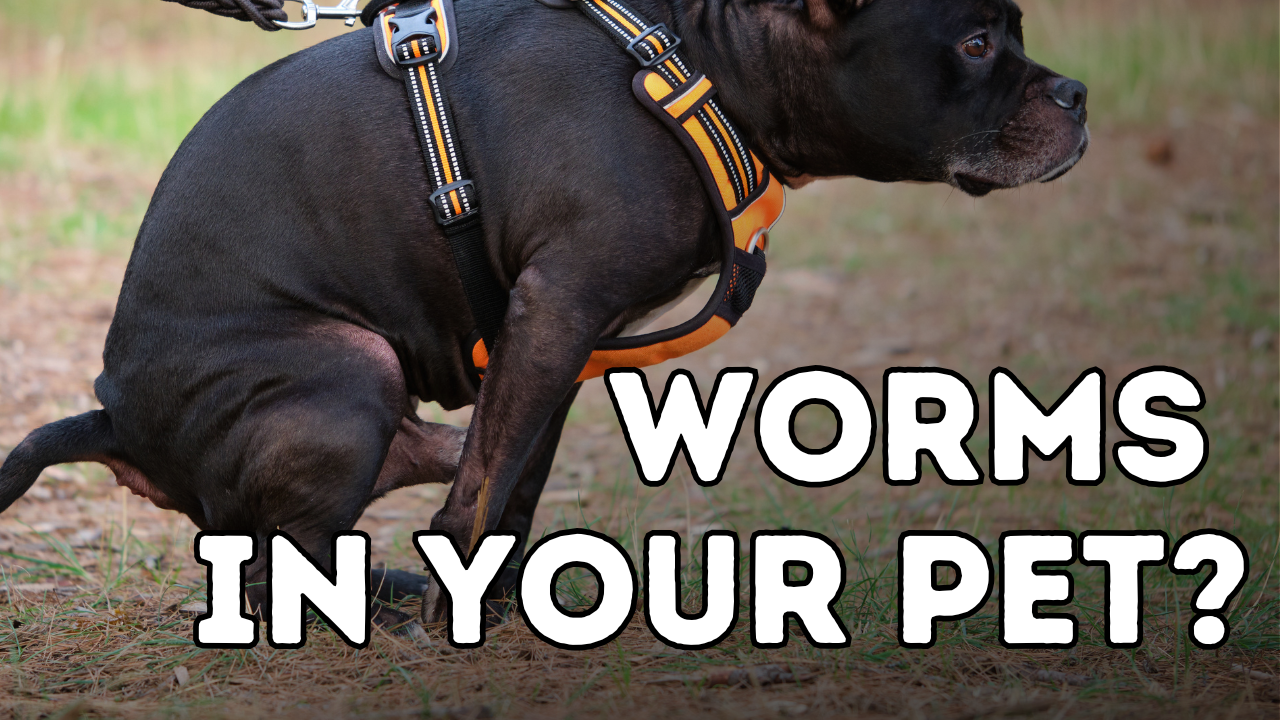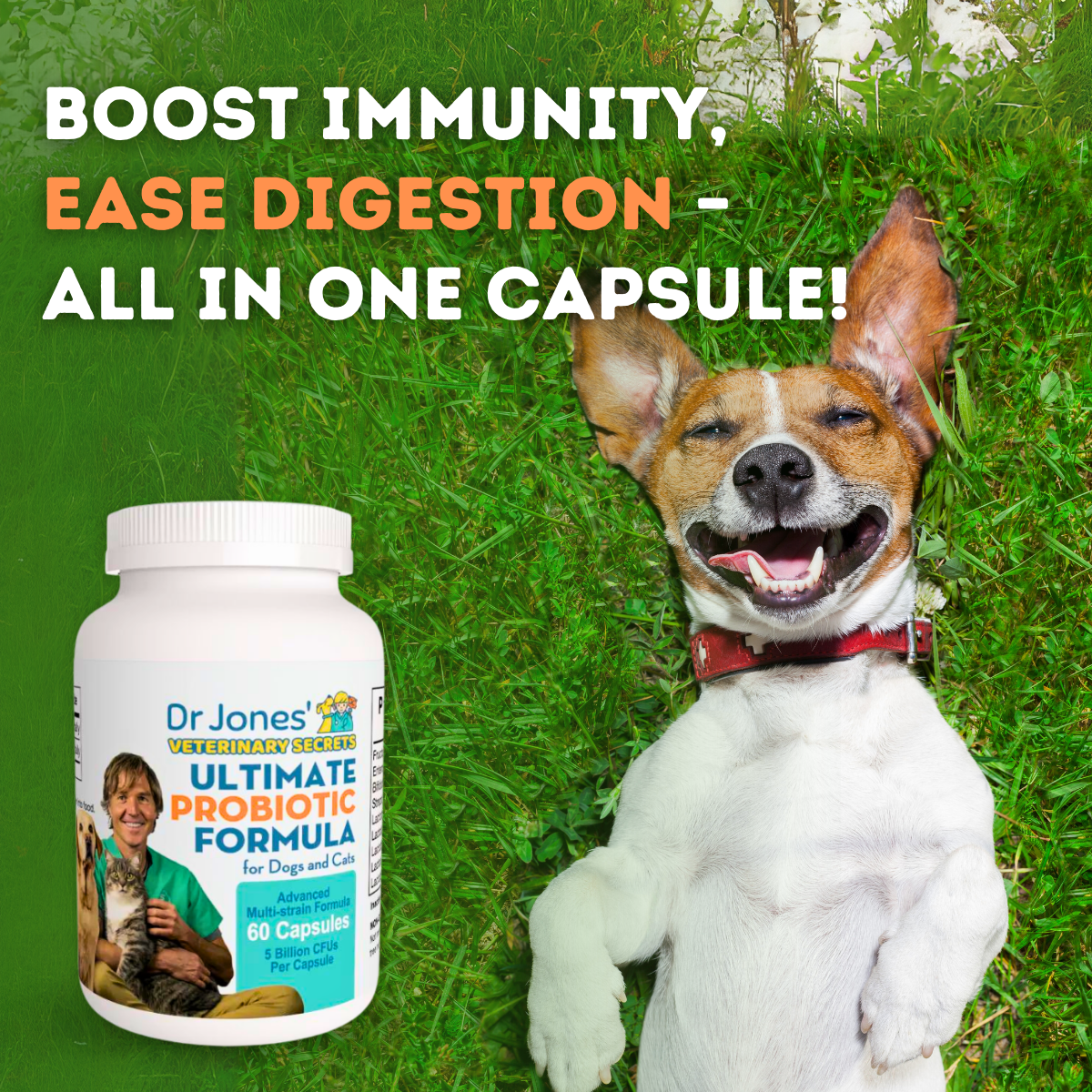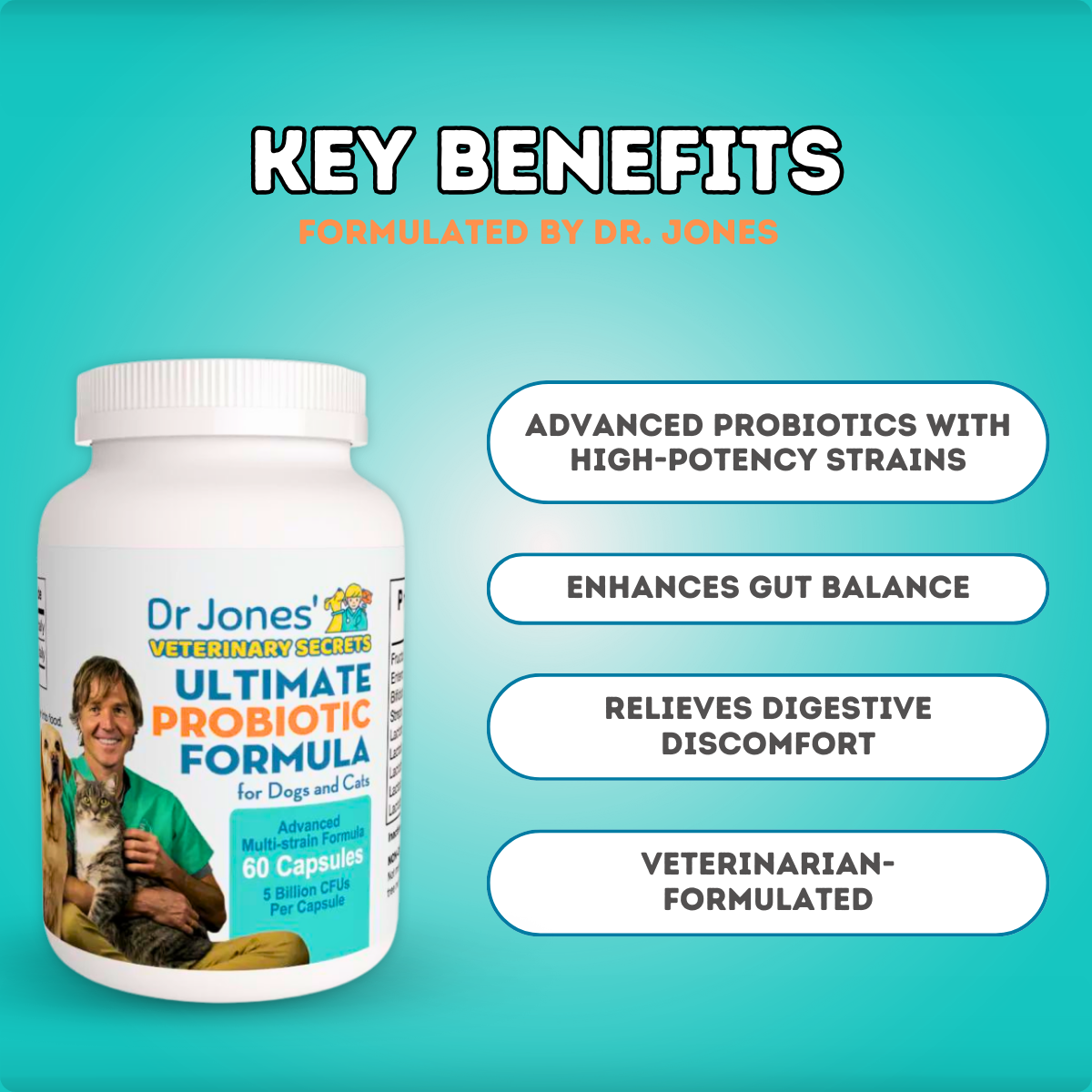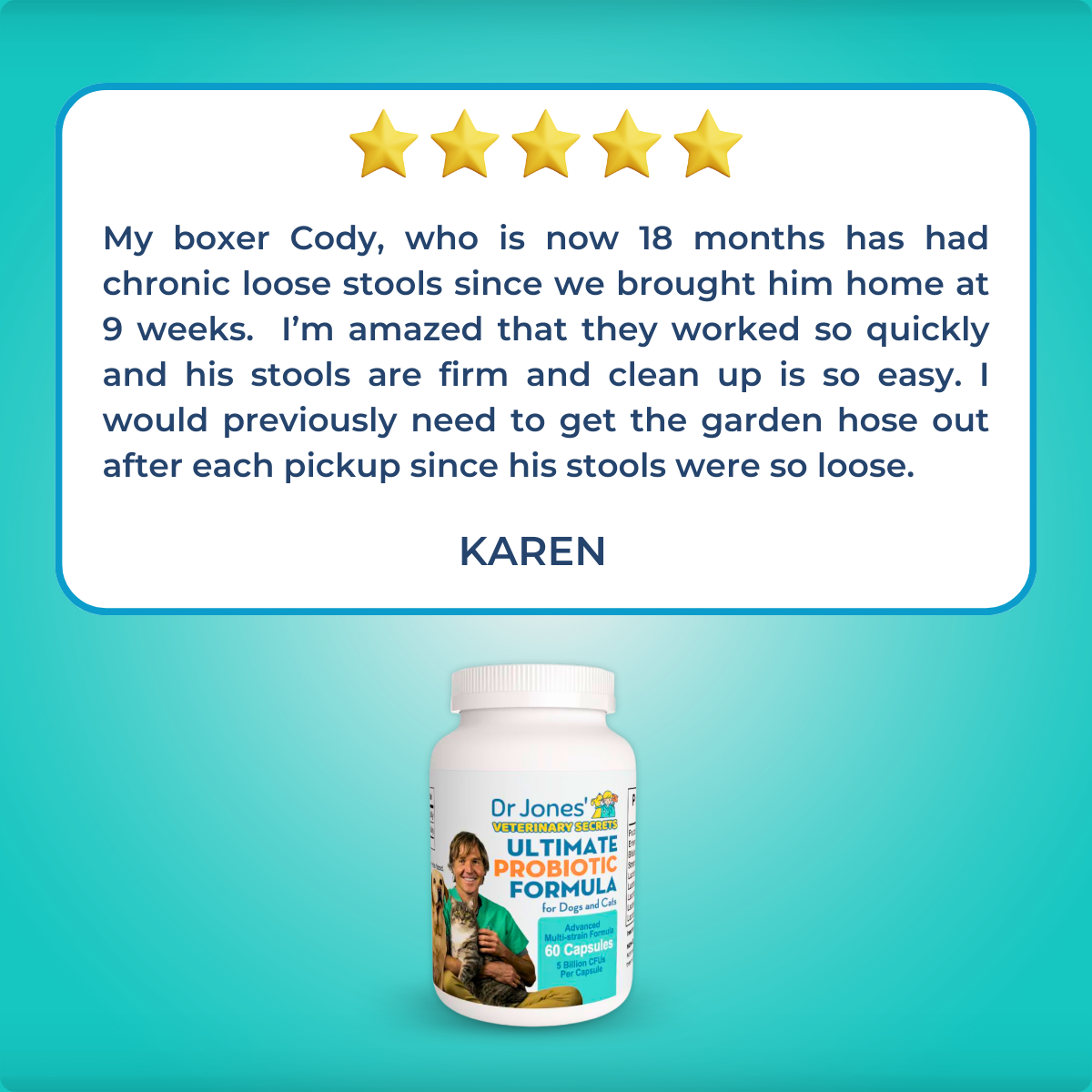Worm in your Pet? Effective Natural Solutions for Worm Prevention in Dogs and Cats

Strengthening Your Pet’s Health: The Power of Probiotics
As a veterinarian, one of the most effective ways I can help your pet manage parasite infestations is by ensuring they have a robust immune system. A key aspect of this is providing additional probiotics to support their gut health.
I’m excited to introduce my new Multi-strain, HIGH CFU Probiotic Supplement! This product is designed to enhance your pet’s digestive health and strengthen their immune system.
Explore Dr. Jones’ ULTIMATE Probiotic Formula for Dogs and Cats

Worms in Dogs and Cats
Signs of Worms in Your Pet
I often encounter concerned pet owners who notice signs of worms in their dogs and cats. You might see small white squiggly worms in your pet’s stool, or your cat may have something resembling grains of rice coming from its rear end. Other signs to look for include vomiting, diarrhea, and unexplained weight loss in your pet.
Causes of Worm Infections
Worms are a common issue in dogs, with up to one-third of all dogs infected with intestinal parasites such as roundworms, tapeworms, coccidia, and giardia. In this article, I will discuss the most prevalent types of worms, how to recognize them in your dog, and ways to prevent and treat these infections—both through conventional medication and natural solutions.
Roundworms
Roundworms are the most common intestinal parasites, measuring one to three inches long, white, and either tapered or round—hence the name. Their veterinary name is Toxocara canis. Most puppies diagnosed with worms have roundworms. Symptoms can include a distended belly that appears bloated, vomiting, diarrhea, and weight loss. Often, pet owners identify roundworms by finding them in their dog’s stool. These worms are easily transmitted from dog to dog through worm eggs in the stool and on the ground.
Tapeworms
The next most common intestinal parasite in dogs is the tapeworm, known scientifically as Dipylidium canis. While many dogs with tapeworms show few clinical signs, a heavy infestation can lead to intestinal upset and weight loss. You can easily diagnose tapeworms by finding segments of the tapeworm in your dog’s stool; these segments are flat, white, and resemble grains of rice. Dogs typically acquire tapeworms after ingesting fleas, as the tapeworm lifecycle includes maturing in a flea before being transmitted to other dogs. Additionally, tapeworms can be transmitted through the ingestion of infected animals, like mice.
Coccidia
Coccidia are microscopic intestinal parasites that can cause diarrhea, especially in puppies, though they can affect older dogs with compromised immune systems. These parasites are spread from dog to dog via eggs in the stool, contaminating water and the environment. Some dogs may have a small number of coccidia in their intestines, but the organism can flourish under stress, such as overcrowded or unsanitary conditions, leading to diarrhea. Coccidia can be diagnosed through a microscopic fecal flotation performed by your veterinarian and should be suspected in any puppy with diarrhea that doesn’t respond to traditional roundworm treatments.
Giardia
Giardia is a waterborne intestinal parasite that more commonly affects adult dogs and causes diarrhea. Often referred to as “beaver fever,” giardia enters the water through contamination from wild animals and infected dogs. The cysts multiply in the intestinal tract, resulting in diarrhea that may contain blood or mucus. Diagnosing giardia can be challenging in veterinary practice; thus, many clinicians will treat dogs with conventional anti-giardia medications without definitive confirmation.
Solutions for Worm Prevention and Treatment
Hygiene and Common Sense
Good hygiene and common sense are your best defenses against worms in dogs. Be diligent about picking up feces from your yard and preventing your dog from eating the feces of other animals. Restrict access to contaminated water sources, like stagnant pools or creeks. Additionally, practicing adequate flea control can help limit the likelihood of tapeworm infections, and ensuring your dog lives in a clean, uncrowded environment decreases the chances of developing coccidia.
Conventional Treatment Options
The treatment for dog worms varies depending on the type of intestinal parasite present:
-
Roundworms: These are treated effectively with a safe medication called pyrantel pamoate. I recommend avoiding older dewormers containing piperazine, as they can be unsafe. Pyrantel treatment typically involves two doses, ten to fourteen days apart. Since most puppies have roundworms, I suggest treating them at six and eight weeks, with additional treatments as needed.
-
Tapeworms: These respond well to praziquantel, which may be combined with pyrantel (as in Drontal); generally, only one dose is required.
-
Coccidia: These parasites respond best to sulfa antibiotics, typically sulfadimethoxine (S-125, or Albon). The dosage is 250 mg per ten pounds once daily for fourteen to twenty-one days.
-
Giardia: This can be treated with two common medications: metronidazole and an older dewormer called fenbendazole. Fenbendazole is effective against other intestinal parasites and is becoming the treatment of choice for giardia, administered at a dose of 250 mg per ten pounds once daily for three to seven days.
Natural Remedies
-
Diatomaceous Earth: This is the most effective and safest holistic dewormer. Ensure you use food-grade DE. Dose at 1/2 teaspoon per 10 lbs twice daily for 21 days to treat most internal parasites; it also works well topically for fleas.
-
Papaya: This fruit has shown effectiveness in eliminating roundworms in pigs and may be beneficial for your pet without any harm.
-
Pumpkin Seed: Known to help with tapeworms, especially in pets that frequently hunt and become reinfested. The dose is one teaspoon per ten pounds of body weight of ground seed.
Herbal Options
-
Black Walnut (Juglans nigra): A common antiparasitic herb for animals. Administer one capsule of the ground herb per twenty pounds of body weight.
-
Garlic: Has shown some activity against giardia and may be useful for recurrent infections. The recommended dosage is 1/4 clove per 10 lbs daily for 14 days.
Homeopathic Treatments
-
Cina: For roundworms, use Cina 30C, one tablet every eight hours for twenty-one days.
-
Filix Mas: For tapeworms, use Filix Mas 30C, one tablet every eight hours for twenty-one days.
Heal Your Pet at Home!
Probiotics have been extensively studied and are key to a strong gut immune system that can better repel parasites. In my opinion, it’s better to prevent these critters than to treat them with conventional medications. Our awesome multi-strain, high CFU probiotic supplement is here: Dr. Jones’ ULTIMATE Probiotic Formula for Dogs and Cats.









About Fenbendazole, I read that it should consumes 3 days in a row, once a day, then wait 4 days. It also should be taken after eating a fatty dinner. Fenbendazole is actually hydrophobic and it is not absorbed well by the bowels. Consuming this with food or after eating makes it absorb better.
It is better to have a break of 4 days after taking Fenbendazole for 3 days, because When utilized in huge amounts for long timeframes without a break, fenbendazole powder may bring on asymptomatic liver enzyme increases because of the material being mostly metabolized inside the liver. This can be reversed with the assistance of a pause for two weeks.
So it is important to give the liver a break.
What is the best dosage, is 222 mg or 250 mg better?
Is Diatomaceous Earth safe for pets with IBD/IBS? Won’t the “scraping/drying out” mechanical properties of DE exacerbate an already compromised GI?
Yes, food-grade diatomaceous earth (DE) is generally considered safe for pets with IBD or IBS when used appropriately. Its mild abrasive properties can aid in digestive health and parasite control without significantly irritating the gastrointestinal tract.